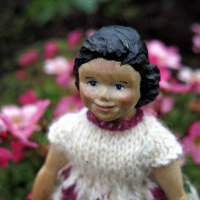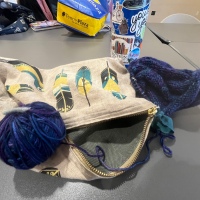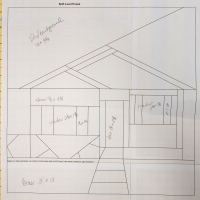Even More Textiles in Philadelphia
Alright, it has been more than a month since I went to Philadelphia, but, as David Letterman used to say, I remember it like it was on videotape!
In the short amount of time I had had to plan my sight-seeing, I had looked up the map of the Philadelphia Museum of Art, and I noticed one teeny tiny room of textiles tucked into a second-floor corner. So after leaving the Perelman Building and crossing the street to the main building, I wandered in that direction.
Before I talk about the textile exhibit, let me just say that I was very impressed with the PMA. To me, a real museum is one where you could never see it all in one day. In some other cities, I have been a little disappointed — sometimes you pay your $20, and get in to see there are only about 6 small galleries, or sometimes the whole museum is given over to a display of butter molds or something, and while I enjoy the viewing, it just seems like there wasn’t that much to see. I end up realizing how spoiled I am by the high quality of our lovely Museum of Fine Art Houston. So I had steeled myself in case the PMA was just an ordinary museum.
But it was amazing! One huge room has a medieval church fountain in the middle with columns all around, one room has some Japanese tea houses. And I saw so many old friends! Picasso’s Three Musicians, Van Gogh’s Sunflowers, Duchamp’s Nude Descending a Staircase. One I was especially happy to see was Degas’ Little Dancer, Aged Fourteen (which I have written about here). And throughout the building, the captions on the art works helped you connect what you were seeing to your background knowledge and to other objects in the museum.
I didn’t know how much time I would have in the museum. I had accompanied my husband on a business trip, and we had thought his business would just take up his morning, and then we would sight-see together in the afternoon. So, I flitted through the museum quickly to make sure I could see the current textile exhibit.
When I got to the gallery, I had to laugh. It was in a very tiny corner, and the lights were off. It was like, “Oh, nobody’s going to set foot in here, we should save on the electric bill.”
When I went in and the lights flickered on, I realized they were on sensors to protect the textiles from too much light, but it still tickled me.
The exhibit was called Without a Stitch , featuring embroidery samplers from the 1700s and 1800s, that included Adam and Eve. So that was a cute concept, stitchery about a pair famous for not wearing a stitch. Now, in spite of my love of textiles, I have been pretty blasé about samplers. You’ve seen one, you’ve seen them all, has been my attitude.
And as usual, once I took a good look, and read what the curators had to say about the pieces, I learned a whole new appreciation. I was amazed at how much variety there was, even within this one theme.
You can see most of the pieces for yourself, if you click the link above, then scroll down to the exhibit title and view slideshow. What you can’t see is the clever captions that were in the actual exhibit. The online ones are more subdued. In the exhibit, for number 5, Sarah Cogger’s sampler, the curator wrote that “Adam and Eve are standing defiantly with their hands on their hips.” For number 16, she wrote, “The grazing rabbits seem oblivious to the snakes with giant red fangs threatening them from behind.” I loved those little statements — it was like the curator was saying, “Well, probably no one is going to come in here anyway, I can say what I want.” And yet they made me look much more closely at those samplers and appreciate the details.
I had some questions. On some of the samplers, the background fabric seemed to be missing rows of weft. I wasn’t sure if it was damage, or if it had originally been woven with irregular spacing to make embroidery easier. On other samplers, there were areas of very long stitches in just one direction, sometimes a half inch or more. They seemed much longer than usual satin stitches. Not knowing much about embroidery, I wondered if those were unfinished areas, that would have had threads needle-woven across them; or damaged areas that had lost some threads; or if that was just how satin stitch was done back a few centuries ago. Well, I thought, I will buy the catalog and read more detail about this!
Only when I got to the bookstore, I couldn’t find any books about this exhibit or stitchery at all. I even asked the store clerk, and she said, “We didn’t do a catalog of that exhibit, because the audience is so small.”
Sigh.
And how will the audience expand, if there are no resources for them to rely on, once the exhibit gets them interested?
I know the museum has to consider their bottom line, but I can’t help thinking it’s a self=fulfilling cycle.
Other textiles I saw throughout the building were wonderful Oriental carpets, velvet bed curtains from the Renaissance, a French carpet woven for the Louvre on a specially-created loom, and a set of tapestries that Rubens designed. But again, since no catalogs were available for these textiles, I really can’t say anything about them, other than they sparked my interest in new areas to research.
I had a wonderful day wandering through the museum, soaking up art in its many forms, and I hope I get the chance to go back some day.
















Lovely. I have always found samplers to be fascinating, as they are so personal. Such interesting ones shown. It seems the exhibitions that interest me never have catalogles either.
When I visited the PMA I didn’t have much time, unfortunately. Something that really impressed me in Philadelphia in general though was the Rodin Museum.
I have heard about the Rodin Museum from some other people too. I will have to visit if I get back to Philadelphia.
You are so right about the samplers being so personal. You really feel you can tell the girls’ personalities from the way they stitched!
Thanks so much for sharing your visit to PMA. I hope I get to see it some day.
It is definitely worth a trip! There is something to appeal to everyone, even a huge display of armor. If my husband had come along with me, I’m sure he would have happily parked himself there while I was off looking for the Impressionists. 🙂
It’s a pity there isn’t a catalog of the sampler exhibition. Your description of your visit was very interesting, it was a bit like being there too 🙂 . What a great museum this must be!
It really has so much phenomenal art, and such good ways of explaining it! Thank you for reading!
I saw that you were nearby and had visited the great Philadelphia Museum of Art.
You were also close to a high-end dealer in samplers, M. Finkel and Daughter (10th and Pine, if you’re ever close again).
They have a web site where you can see the sort of thing they offer:
http://samplings.com/current-selections
FYI,
R. John Howe
Washington, DC
They had such amazing Oriental rugs too! I was thinking of you and your wonderful blog, and wishing I knew more about what I was looking at. I know the basics of rug weaving technique, but not any of the details about their creators’ individual locations or styles. I read about all that, but it is such a huge field, and I haven’t studied it enough for it to stick in my head and make me feel I know it.
I will look at the website! Thank you.
I looked at the website — wow! I’m glad they leave the pieces up even after they have sold, because then we can all enjoy looking at them and we can learn something too from the information they post. There was even one with Adam and Eve, but no snake! I think that is a variation not seen in the exhibit.
I always love stumbling across an exhibit like this. 🙂 Did you happen to get a list of the artists’ works and names that were featured? Sometimes when the museum doesn’t produce a catalog, just having the artist’s name can help with follow-up research later.
The website gave a list of the stitchers. I think for some of them they know their whole life story. And also, in looking at the ones online, I noticed similarities between some of the samplers, that I didn’t notice when I was there in person. It did make me curious about whether these girls had had the same teacher, or knew each other, etc.
Just looking for “samplers” online, though, led me to another wonderful resource that I will do a post about later!
As I may have said before, I’m from Philly, and was spoiled to be able to wander down to the PMA from my first job located at Logan Circle. And the Rodin Museum is great, too. I recall rooms of furniture at the PMA as well as a great painting collection. Recently the Barnes Foundation moved into the city from the burbs, and it has a superb collection of Impressionist art. What I know about samplers is from Antiques Road Show. I think young ladies’ finishing schools required their students to turn out samplers, though I don’t think they’d consider naked people appropriate subjects, however Biblical.
I know most of my ideas about samplers are from Antiques Road Show too! Maybe that’s why I wasn’t expecting so much variety; after all, I’m sure they don’t show more than one per season and they seem to show the same type each year. Or maybe that’s when I go out of the room looking for popcorn. 🙂
I got to go to the Barnes too and that will get its own post. Philly was a wonderful city to walk in. I don’t know if you’ve ever been to Houston – we’ve got the same kind of diversity as Philly, and lots of fun attractions, but since Houston wasn’t really settled until the advent of air conditioning, it is very spread out and not walker-friendly.
I’ve never been to Philly but your post has helped move it up my list. Thanks for sharing your delight and excitement on the textile room, and the great curator’s labels.
While in Edinburgh we visited the National Museum of Scotland. That was one of the best museums I’ve ever been in. !!! 🙂
Scotland is definitely on my list! My husband has been there a few times for business and he would like to go back, so it might really happen.
If you get that lined up, let me know. I’m no expert but there were a couple of things I’d definitely recommend.
Loved your write up about your visit–my sister lives in Philly, so I guess I’d better get ther and take a look!
There is so much to see there! The art museum could definitely take up a full day!
Surely somebody has written a useful treatise on mideival embroidery, though I personally wouldn’t know where to find it. Good luck!
Yes, I actually own a couple of embroidery books too — it’s just that I am fussy and I want to read about the very pieces I saw in an exhibit. I want details like, “We know this damage was done by her father’s hunting dogs,” or “Sarah and Molly both attended the same dame school, but 16 years apart,” and things like that. 🙂
That was very enlightening……I do hope you wrote to/sent your blog to who ever is in charge of this area of the museum. Thanks as always!
I did email the museum before my first post about it, to ask permission to use one of their pictures. I never heard back, which is a first from a museum. They had signs all over about letting them know what you thought on Twitter or something, but I don’t know how to do that. So I hope they will just sense my good opinions. 🙂
[D] Curiosity makes the world a much better place – and now I’m the better for yours!
I am glad I kept this blogpost sitting in my inbox until I had time to read it – it’s a treat! Those samplers are just fascinating, and how wonderful it is that we can all see the digital copies online (even if the clever captions on show in the museum were missing!). I was recently in the Victoria & Albert Museum in London – and found similarly that there were little pockets of the museum with little-visited treasures where nobody seems to go . I guess these places just have so much to show – probably masses and masses more in their vaults. Anyhow, so good you’ve been able to shed a little light on these samplers with your blog. Thank you so much.
Pingback: Creative Juice #14 | ARHtistic License